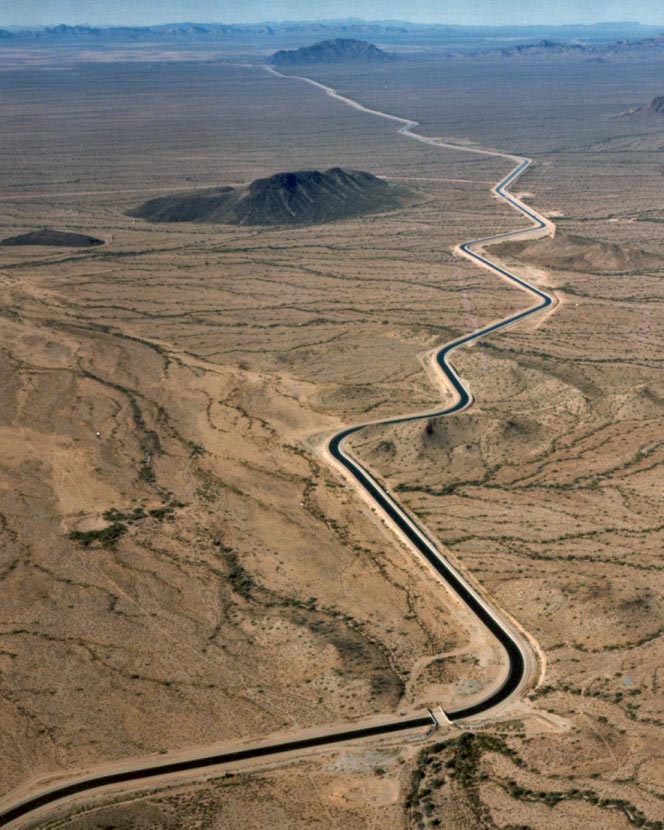Domesticating Water
Water is the most immediate requisite element for human survival. For most of humanity’s history (written and unwritten), where people could live was constrained by the need to remain in proximity to drinkable water. Cultures used natural containers such as gourds, animal bladders, and animal skins to transport and store water for immediate personal use. It wasn’t until populations learned how to “domesticate” water, though, that they were able to consolidate and spread the farming lifestyles that led to the population growth humans have maintained since Neolithic times. Even though water has retained many of its wild and free characteristics, archaeologist Steven Mithen believes we should consider water domesticated, since “its natural properties have been constrained and manipulated to cater for human need.”
The Flint water crisis and the California drought exemplify, in two different but related ways, the problem that contemporary cultures face because of every human’s need for access to water. Water control systems bring us our necessary liquid, but they also serve as a firm reminder that the ways we store, transport, and distribute water (which have allowed humans to create large cities and, ultimately, advanced civilizations) may have reached a tipping point beyond which they could begin to create more problems than they solve.
The Neolithic Revolution
Prior to about 11,000 years ago, people lived primarily by hunting wild animals and gathering plants in their natural habitats. Over time, humans began to encourage particular plants to grow, while discouraging others. People came to rely more on the food provided by those plants, and they placed their communities nearby to protect their crops from animals and other people. As more and more people began living in a localized space, the need for more plant resources grew, which produced a need for more consistent water than was provided by rain.
As gatherers became farmers, they recognized that more consistent supplies of water resulted in better crop yields and healthier animals. The creation of water control systems, such as wells, cisterns, runoff diversion systems, and, eventually, irrigation, allowed populations to provide water for crops without relying solely on local rainfall. Water control was part of the Neolithic Revolution, as V. Gordon Childe called it, and, along with plant and animal domestication, it allowed people to consolidate and create denser population areas.
The development of these water control systems, though, created a concomitant need to control access to the water. In the late 1940s and early 1950s, anthropologists Karl Wittfogel and Julian Steward proposed that this control was a major factor in the development of early civilizations. Increased food production, they argued, led to increased population; increased population led to a need for increased food production to feed the larger population; increased food production required more water; increased demand for water required that it be apportioned in some way; and increased need for apportionment led to a need for greater control in order to prevent tension over conflicting demands for water.
Ultimately, whoever controlled the water had to maintain that control in one (or some combination) of three ways: through force, by having permission from those who needed the water, or by being able to negotiate with all the parties involved. People accepted the decisions of the water administrator to withhold or provide water, but they also came together under the administrator’s direction to construct or maintain water control structures. This centralized control led to greater integration of various family groups as they united for a common cause under an acknowledged leader, thus creating more-complex social organizations.
Acequías
Smaller irrigation systems that rely on centralized control still exist in northern New Mexico. Acequías (community-operated watercourses used for irrigation in Spain and former Spanish colonies in the Americas) remain in use to deliver water to crops. The community comes together throughout the year, under the lead of the mayordomo, or “ditch boss,” to clean and maintain the ditches. A friend of mine is a mayordomo of an acequía near Abiquiu, New Mexico. His role is to ensure equitable water distribution, and he makes himself available to address issues that come up throughout the growing season, as well as during the off-season. As a result of his role as ditch boss he is known in the community, and people seek him out for socializing as well as for “ditch business.” It’s a year-round commitment, but my friend finds the community interaction to be deeply satisfying.
Early water control systems may not have functioned in the same way as contemporary acequías. Nonetheless, the way modern-day New Mexico residents organize into a community-wide group to manage water as a shared resource helps us understand how human organizational complexity might have developed in response to similar situations.
Hohokam and the Central Arizona Project
Domesticating water contributed to the growth of societies in other ways as well. While the origins of the Neolithic may have been in southwest Asia, similar needs often led to similar solutions in other parts of the world. Today, we have large, mega-expensive water control and irrigation systems in the Central Valley of California and in central Arizona, where concrete canals transport millions of gallons of water from mountains and rivers to croplands far away from the original water sources. These methods of moving water from one place to another are not new technological advances—they are the result of honing systems created long ago.
The Hohokam of central and southern Arizona, for example—a major cultural group that thrived from about A.D. 200 to 1400—created irrigation systems that helped them deal with water scarcity in their semi-arid environment. Their canal systems brought water from rivers and dispersed it across the nearby landscape. Archaeologists believe that the construction, maintenance, and operation of these canal systems would have required a substantial and well-organized effort—an investment of time beyond that available to a single household or family. Also, because of the possibility of conflicts over water, strong leadership must have been necessary to quickly resolve disputes that could threaten the cooperative ventures needed to run the canals.
The Hohokam canal system was the blueprint, of sorts, for the Central Arizona Project in use today. Billed as Arizona’s single largest resource for renewable water supplies, the Central Arizona Project was designed to bring about 1.5 million acre-feet of water from the Colorado River to central and southern Arizona every year. More than 5 million people (over 80 percent of Arizona’s population) rely on the water transported along its 336-mile-long system of aqueducts, tunnels, pumping plants, and pipelines. Canals in Phoenix deliver water to homes and golf courses, and the resultant increase in green space has actually led to a rise in the humidity that many visitors go to Arizona to escape.
In spite of—and partly because of—our ability to domesticate water, the growing demands on the world’s water resources to meet human, commercial, and agricultural needs are creating local and regional crises and fueling global concern. The United Nations General Assembly declared 2003 the International Year of Freshwater. It also proclaimed 2005–2015 the Water for Life Decade, which began on March 22, 2005, the day that is now observed annually as World Water Day. More importantly, in July 2010, the United Nations General Assembly recognized that it is the right of every human being to have local access to sufficient safe, acceptable, and affordable water for personal and domestic uses.
We humans have been shrewd in using our intelligence to solve complex issues that we have faced in the past. Domesticating water allowed us to create food surpluses, which in turn led to large urban centers and great civilizations. Now, however, we must be aware of the water crisis looming ahead. We continue to rely on transporting water from far-flung places to areas where we want it for personal, agricultural, and industrial uses, but we will not be able to continue on this trajectory indefinitely. While it is unlikely we’ll ever need to return to our pre-Neolithic reliance on living in the immediate vicinity of water, we will need to develop new ways of managing water, some of which may be based on old ways. All of us need to be thinking a lot more about the nature of water, how we use it, and how we will need to adapt to a changing world in which water is an increasingly scarce and precious resource.



























